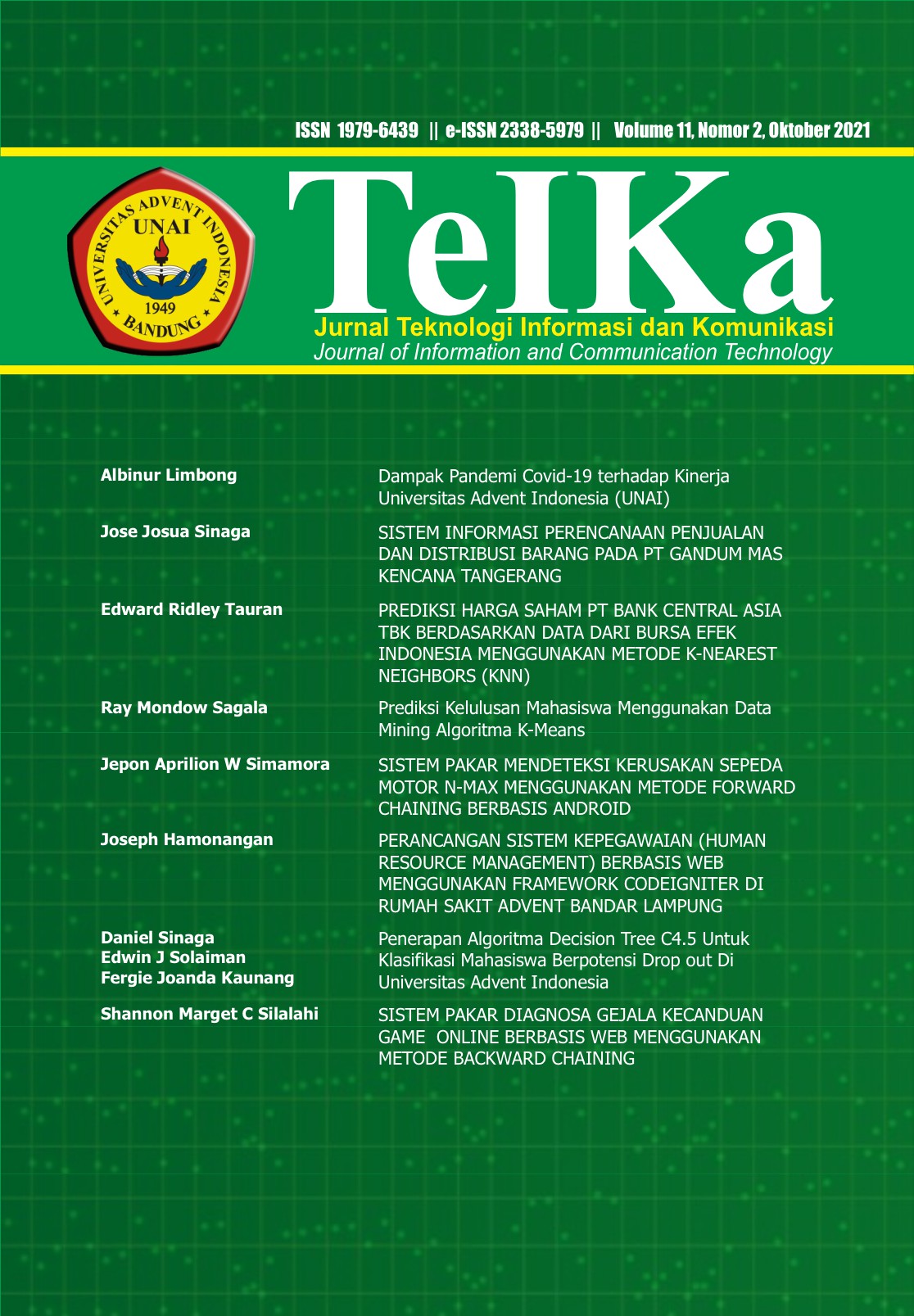Prediction of college student using K-Means Algorithm Data Mining
Keywords:
Graduation, Course, Prediction, K-Means, Chi Square Attribute Selection, Confusion MatrixAbstract
Graduation of a course is very important, if there are students who do not pass a course, especially subjects that have an attachment to another course, must take back the course. Graduation in a course cannot be known before the final exam and final grade calculation are calculated. For this reason, it is necessary to predict the graduation of courses to help anticipate what makes students fail in a course.Through the literature study stage, interviews and looking at academic performance data obtained, the assignment values, unit test values, mid test scores, and attendance obtained from performance data and internal and external factors of students such as class activity, status of residence, language lesson, and the form of the final project given. Data processing is performed using K-means, then calculate the chi square atribute selection and calculate the accuracy of the prediction using a confusion matrix.The results of the study showed that the prediction results using K = 3 of 118 data processed there were 13 students who did not pass, 36 students graduated with sufficient grades, and 69 students graduated with good grades. And what influences the graduation prediction using the chi square atribute is a mid value with ranked atributes of 49, an assignment value of 46, and attendance of 42. Language material using English influences students who graduate with sufficient grades. While the final project in the form of a project or a theory test does not greatly affect the predictions of student graduation in a course. The use of confusion matrix to the prediction results shows an accuracy rate of 93% with precision and recall of 96% and 92%.
Downloads
References
Agusta, Yudhi. 2007. ‘K-Means penerapan permasalahan dan metode terkait’. Jurnal Sistem dan Informatika, Vol 3.
Baradwaj, B. K., & Pal, S. (2011). Mining Educational Data to Analyze Students‟ Performance. International Journal of Advanced Computer Science and Applications.
Borkar, S., & Rajeswari, K. (2014). Attributes Selection for Predicting Student's Academic Performance using Education Data Mining and Artificial Neural Network. International Journal of Computer Applications .
C, D. A., Baskoro, D. A., Ambarwati, L., & Wicaksana , I. S. (2013). Belajar Data Mining Dengan Rapid Miner. Jakarta: Remi Sanjaya.
Darmi, Y., & Setiawan, A. (2016). PENERAPAN METODE CLUSTERING K-MEANS DALAM PENGELOMPOKAN PENJUALAN PRODUK. Jurnal Media Infotama, 148.
Herdianto. (2013). Prediksi Kerusakan Motor Induksi Menggunakan Metode Jaringan Saraf Tiruan Backpropagation ”. Universitas Sumatera Utara, 8.
Indrawan, B. R. (2018). Penerapan Algoritma K-means Untuk Menentukan Strategi Promosi Universitas Islam Negeri Sunan Kalijaga Yogyakarta. 34.
Jaya, D. I. (2006). Perancangan dan pembuatan perangkat lunak berbasis jaringan syaraf tiruan untuk memprediksi harga saham dengan menggunakan metode backpropagation. Scientific Repository.
Murti, D. H., Suciati, N., & Nanjaya, D. J. (2005). CLUSTERING DATA NON-NUMERIK DENGAN PENDEKATAN ALGORITMA K-MEANS DAN HAMMING DISTANCE STUDI KASUS BIRO JODOH . JUTI, 48.
Praja, B. S., Kusuma, D. D., & Setianingsih, C. (2019). APLICATION OF K-MEANS CLUSTERING METHOD IN PASSENGER AND SHIP TRANSPORT DATA GROUPING IN INDONESIA. e-Proceeding of Engineering, 1442.
Purnamasari, D., Henharta, J., Sasmita, Y. P., Ihsani, F., & Wicaksana, I. S. (2013). GET EASY USING WEKA. Jakarta: Dapur Buku.
Sibarani, R., & Chafid. (2018). ALGORITHMA K-MEANS CLUSTERING STRATEGI PEMASARAN PENERIMAAN MAHASISSWA BARU UNIVERSITAS SATYA NEGARA INDONDESIA [ALGORITHMA K-MEANS CLUSTERING STRATEGY MARKETING ADMISSION UNIVERSITAS SATYA NEGARA INDONESIA]. Seminar Nasional Cendekiawan , 687.
S, R. (2015). Python machine learning. Packt Publishing Ltd, 190.
Subkhan, M. (2010). Algoritma Clustering.
Sugiono, Nurdian, S., Linawati, S., Safitri, R. A., & Saputra, E. P. (2019). Pengelompokan Perilaku Mahasiswa Pada Perkuliahan E-Learning dengan K-Means Clustering . Jurnal Kajian Ilmiah Universitas Bhayangkara Jakarta Raya , 128.
Suprayogi. (2018). Data Mining Clustering.
Downloads
Published
How to Cite
Issue
Section
License
Copyright (c) 2021 TeIKa

This work is licensed under a Creative Commons Attribution-ShareAlike 4.0 International License.
The submitting author warrants that the submission is original and that she/he is the author of the submission together with the named co-authors; to the extend the submission incorporates text passages, figures, data or other material from the work of others, the submitting author has obtained any necessary permission.
Articles in this journal are published under the Creative Commons Share Alike Attribution Licence (CC-BY-SA What does this mean?). This is to get more legal certainty about what readers can do with published articles, and thus a wider dissemination and archiving, which in turn makes publishing with this journal more valuable for you, the authors.
By submitting an article the author grants to this journal the non-exclusive right to publish it. The author retains the copyright and the publishing rights for his article without any restrictions.










